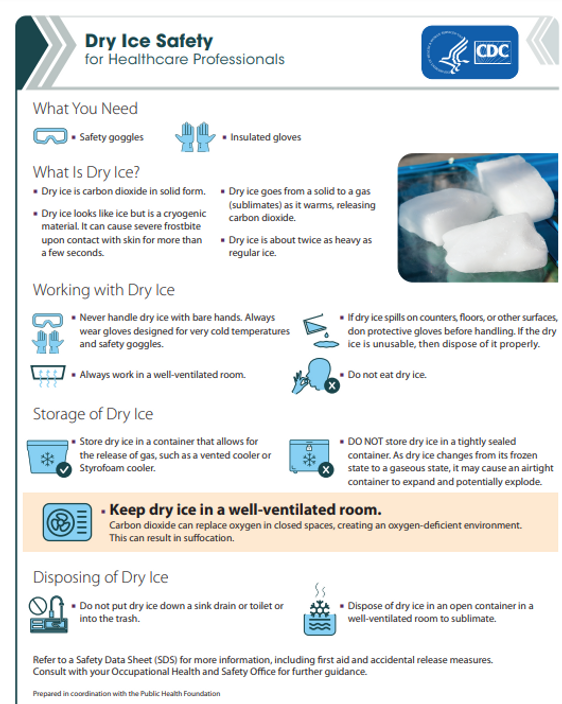
CO2 (DRY ICE) POISONING
Carbon Dioxide (Sublimation of DRY ICE) Poisoning
CASE REPORT: DEATH FROM IMPROPER HANDLING OF DRY ICE
After removing the frozen food from the boxes, the opened boxes (with dry ice still in them) were left open in the back seat of the car. The dry ice sublimated to CO2 and oxygen was then replaced with CO2. The occupant (unaware of a problem) then entered the car (closed the door) and drove off in a car with no oxygen. THE OCCUPANT WAS THEN FOUND DEAD OF SUFFOCATION IN THE WRECKED CAR..
DRY ICE is frozen carbon dioxide (CO2). The surface temperature of dry ice is –109.3° F (–57° C). Above this temperature, dry ice sublimes, or sublimates. Sublimation is when a substance turns directly into a gas without first becoming liquid. This means that dry ice will evaporate without leaving moisture or wetness. It is used in many industrial applications, frequently for preserving frozen foods in the shipping process.
CARBON DIOXIDE POISONING:
Even small amounts of Dry Ice can produce large quantities of carbon dioxide as it turns from a solid to a gas. Carbon dioxide is in the air we breathe and at high concentrations it has toxic effects. It quickly replaces oxygen in the air and thus poisoning and suffocation can be caused by dry ice sublimating in enclosed, poorly ventilated spaces.
SYMPTOMS OF DRY ICE POISONING:
Rapid breathing is an early symptom of carbon dioxide exposure. Other symptoms of carbon dioxide poisoning are similar to those of oxygen deprivation (suffocation) and include headache, dizziness, drowsiness, and if left untreated UNCONSCIOUSNESS, AND DEATH.
DISPOSING OF DRY ICE:
Allowing dry ice to sublimate at room temperature is an effective way to dispose of it, but it's important to take precautions to help prevent hazards.
.Make sure to allow dry ice to sublimate only in well-ventilated areas to avoid a harmful buildup of CO2.
·Do not leave dry ice unattended in public places.
·Never dispose of dry ice in a toilet, sink or garbage disposal. The extreme cold can damage plumbing.
·Never dispose of dry ice in a trash can.
·Avoid putting dry ice directly on tile or laminated countertops. The cold can weaken adhesives and cause cracking.
TREATMENT OF DRY ICE BURNS:
Skin contact with dry ice can cause frostbite. OSHA recommends treating dry ice contact injuries as possible:
·Get medical assistance as soon as possible
·Remove clothing that is not frozen to the skin
·Put the affected body part in a bath of warm water—not above 40° C, or 104° F.
·Do not use dry heat to warm the area.
·Do not rub the affected area.



